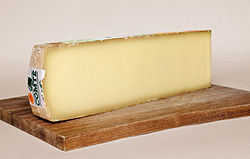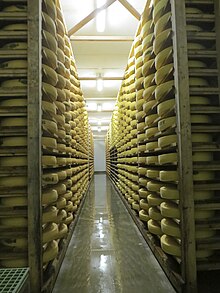Comté cheese
This article needs additional citations for verification. (April 2015) |
| Comté | |
|---|---|
 | |
| Country of origin | France |
| Region | Franche-Comté |
| Source of milk | Cows |
| Pasteurised | No |
| Texture | semi-hard |
| Aging time | 4–36 months |
| Certification | French AOC 1958 |
Comté (French pronunciation: [kɔ̃te]) is a French cheese made from unpasteurized cow's milk in the Franche-Comté region of eastern France bordering Switzerland and sharing much of its cuisine. Comté has the highest production of all French Appellation d'origine contrôlée (AOC) cheeses, at around 65,000 tonnes (72,000 short tons) annually.[1] It is classified as an Alpine cheese.
The cheese is made in discs, each between 40 and 70 cm (16 and 28 inches) in diameter, and around 10 cm (4 inches) in height. Each disc weighs up to 50 kg (110 lb) with a fat in dry matter (FDM) around 45%. The rind is usually a dusty-brown colour, and the internal paste, pâte, is a pale creamy yellow. The texture is relatively hard and flexible, and the taste is mild and slightly sweet.
Production
[edit]Fresh from the farm, milk is poured into large copper vats where it is gently warmed. Each cheese requires up to 600 litres (160 US gal) of milk. Rennet is added, causing the milk to coagulate (curdle). The curds are then cut into tiny white grains that are the size of rice or wheat which are then stirred before being heated again for around 30 minutes. The contents are then placed into moulds and the whey is pressed out. After several hours the mould is opened and left to mature in cellars, first for a few weeks at the dairy, and then over several months elsewhere.
The manufacture of Comté has been controlled by AOC regulations since it became one of the first cheeses to receive AOC recognition in 1958, with full regulations introduced in 1976. The AOC regulations for Comté prescribe:[2]

- Only milk from Montbéliarde or French Simmental cows (or cross breeds of the two) is permitted.
- There must be no more than 1.3 cows per hectare of pasture.
- Fertilization of pasture is limited, and cows may only be fed fresh, natural feed, with no silage.
- The milk must be transported to the site of production immediately after milking.
- Renneting must be carried out within a stipulated time after milking, according to the storage temperature of the milk.
- The milk must be used raw. Only one heating of the milk may occur, and that must be during renneting. The milk may be heated up to 56 °C (133 °F).[3]
- Salt may only be applied directly to the surface of the cheese.
- A casein label containing the date of production must be attached to the side of the cheese, and maturing must continue for at least four months.
- No grated cheese could be sold under the Comté name between 1979 and 2007.[4]
In 2005, the French Government registered 175 producers and 188 affineurs (agers) in France.[5]
Grading
[edit]Each cheese is awarded a score out of 20 by inspectors: the highest possible scores are 1 point for overall appearance, 1.5 for quality of rind, 3.5 for internal appearance, 5 for texture, and 9 for taste. Those cheeses scoring higher than 14 points[6] are given a green casein label with the recognizable logo of a green bell, and are called Comté Extra. Those cheeses scoring from 12 to 14 points are given a brown label and are called simply Comté. Any cheese scoring only 1 or 2 points for taste (out of the possible 9), or scoring below 12 overall, is prohibited from using the Comté name and is sold for other purposes.
Jury terroir
[edit]
Comté is well known for its distinct terroir: it is made in 160 village-based fruitières (cheese-making facilities) in the region, owned by farmers who bring milk from their own cows; strict production rules linking place and product; and the seasonal environmental effects. Comté cheeses go through the process of "jury terroir", where panels of trained volunteer tasters from Comté supply chain and from the region discuss and publish bi-monthly in the newsletter Les Nouvelles de Comté about the taste and their results. This jury terroir was created by Florence Bérodier, a food scientist, to elaborate in response to a set of formidable challenges that Comté cheese underwent in the beginning for its unfamiliar taste and smell. "The jury terroir is there to speak of all the richness in the tastes of a Comté…" – the original member confirmed. For Comté cheese to be world-renowned, the quality improved, but the challenge stand still to create a uniform taste, which was impossible to achieve since there were 160 different fruitières specializing. But through the process of jury terroir, people came to focus on communication among the tasters, which improved their ability to perceive and gained in value. They acquired a general culture that enabled them to describe and exchange the taste of Comtés.[7]
See also
[edit]References
[edit]- ^ "Le marché du Comté" [The Comté Market] (in French). Archived from the original on 19 March 2016. Retrieved 18 August 2016.
- ^ "Décret de l'AOC comté" (in French). Retrieved 14 May 2010.
- ^ Making of Comte (Official). Retrieved 8 February 2017 – via YouTube.
- ^ "Retrospective : les grandes dates du cigc" (in French). Retrieved 3 July 2017.
- ^ "Comté" (in French). Inao.gouv.fr. Retrieved 13 September 2013.
- ^ "In the Cellar (Aging Comté)". Comte USA. Retrieved 28 December 2019.
- ^ Shields-Argelés, Christy (2016). "The Comté Aroma Wheel: History of an Invention, Ethnography of a Practice, A Look at the Early Years". Food & Communication. pp. 363–72.
External links
[edit]![]() Media related to Comté (cheese) at Wikimedia Commons
Media related to Comté (cheese) at Wikimedia Commons
